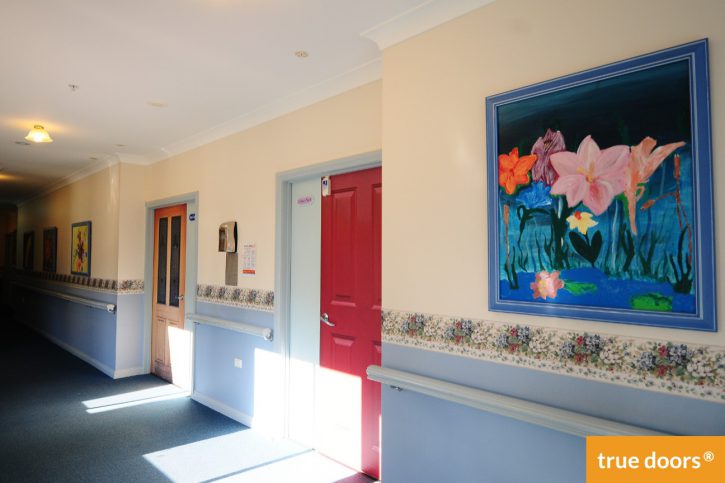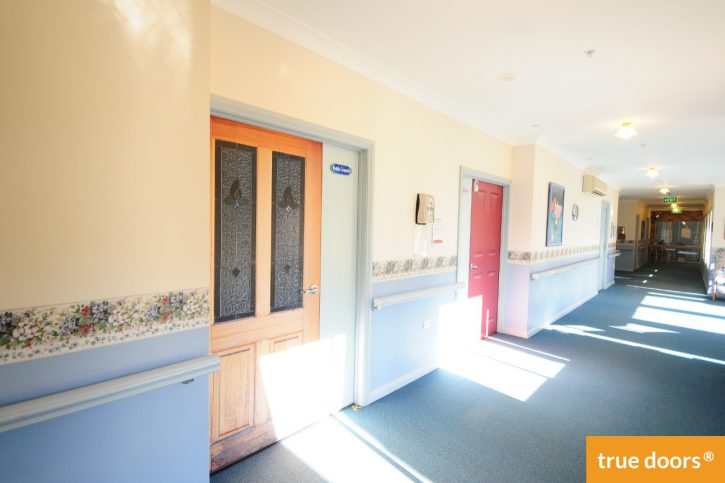Checklist for Stimulating Reminiscence and Social Interaction
Stimulating reminiscence and promoting social interaction are crucial in dementia care environments. These activities help maintain cognitive function, enhance mood, and foster a sense of community among residents. Here’s a checklist to help stimulate reminiscence and encourage social interaction, including the role of True Doors in this process.

The Checklist
1. Environmental Design and Decor
- True Doors:
- Personalized Door Covers: Install True Doors that replicate or are similar to the appearance of doors from residents' previous homes or are door designs that residents aspire to own. This familiar visual cue can evoke memories and aspirations in order to encourage residents to share stories about their past experiences, stimulating reminiscence.
- Enhanced Social Interaction: True Doors help residents easily identify their own rooms and the rooms of their neighbors, which often encourage casual conversations and social visits among residents, fostering a sense of community.
- Themed Spaces:
- Create themed areas that reflect different time periods or cultural settings familiar to the residents. For example, a 1950s-style kitchen or a vintage reading room can prompt residents to reminisce about their youth and spark conversations with others.
- Memory Walls:
- Use memory walls or boards in communal areas that display photos, memorabilia, and artifacts from the residents' pasts. Rotate the content regularly to keep it fresh and engaging, encouraging ongoing reminiscence and discussion.
- Comfortable Communal Areas:
- Design living rooms, dining areas, and lounges to feel like home, with cozy furniture and decor that invites conversation. Arrange seating in small clusters to facilitate social interaction.
2. Activities and Programs
- Reminiscence Therapy Sessions:
- Organize group reminiscence therapy sessions where residents can share stories from their past. Use prompts such as photos, music, or items from the past to encourage discussion and memory sharing.
- Music and Memory:
- Play music from the residents’ youth or familiar cultural songs during activities or in common areas. Music is a powerful trigger for memories and can prompt residents to sing along or discuss their favorite songs with peers.
- Storytelling Circles:
- Host storytelling circles where residents take turns sharing their life experiences, guided by a facilitator or staff member who can prompt and engage the group. This can be a powerful way to stimulate reminiscence and encourage social bonding. This can include a tour of your street or neighborhood that takes in and stimulates storytelling around the story behind residents’ True Doors.
- Group Activities:
- Encourage participation in group activities such as arts and crafts, gardening, or cooking. These activities provide opportunities for residents to work together, share skills, and engage in conversations about their past experiences.
3. Use of Technology
- Digital Reminiscence Tools:
- Implement digital tools like tablets loaded with old photographs, videos, and music that residents can explore individually or in small groups. These tools can prompt memories and stimulate discussions about shared experiences.
- Virtual Reality (VR):
- Use VR experiences to transport residents to familiar places or events from their past. This immersive technology can trigger memories and provide a rich basis for social interaction.
4. Engagement with Families and Friends
- Family-Led Activities:
- Invite family members to participate in reminiscence activities, such as sharing old family albums or telling stories. This not only helps residents recall memories but also strengthens bonds with family members. This can include projects that involve families in selecting residents’ True Doors, which helps family members stay connected with residents.
- Intergenerational Programs:
- Organize activities that involve children or young adults, such as storytelling sessions or craft projects. These interactions can stimulate conversations about the past and provide residents with a sense of purpose and connection to younger generations.
- Flexible Visiting Hours:
- Allow flexible visiting hours to encourage family and friends to spend more time with their loved ones. Consider organizing regular family days where multiple generations can come together, fostering intergenerational interactions.
5. Sensory Engagement and Outdoor Spaces
- Sensory Gardens:
- Create sensory gardens with plants that have familiar scents, textures, and colors. Gardening activities can stimulate memories of past experiences with nature and provide opportunities for social interaction.
- Animal-Assisted Therapy:
- Introduce pet therapy programs where residents can interact with animals. The presence of pets can evoke memories of past pets and provide comfort and joy, leading to increased socialization.
- Accessible Outdoor Areas:
- Provide safe and secure outdoor areas for residents to enjoy. Encourage outdoor activities such as walking, bird-watching, or picnics, which can promote social interaction and reminiscence.
6. Staff Training and Role
- Facilitating Conversations:
- Train staff to facilitate conversations about the past by asking open-ended questions, showing interest in residents’ stories, for example around their True Doors, and encouraging them to share memories. Staff should be familiar with the residents’ backgrounds to better engage them in reminiscence activities.
- Encouraging Participation:
- Encourage staff to actively involve residents in activities and programs that stimulate reminiscence. Staff should use gentle prompts and reminders to help residents recall memories and participate in discussions.
- Positive Reinforcement:
- Use positive reinforcement to encourage residents to engage in social interactions and share their stories. Praise residents for their participation and contributions to group activities.
7. Regular Evaluation and Updates
- Monitor Effectiveness:
- Regularly assess the effectiveness of reminiscence activities and social programs by observing resident engagement and gathering feedback from residents, families, and staff.
- Adapt to Resident Needs:
- Update and adapt programs based on residents' changing needs and interests. Ensure that activities remain meaningful and enjoyable for all participants.

By following this checklist and incorporating True Doors, care facilities can create an environment that stimulates reminiscence and promotes social interaction, enhancing the quality of life for residents with dementia.
%20and%20after%20(right)%20shot%20with%20Joy%20Lovell%20after%20a%20True%20Doors%20Transformation%20at%20Cypress%20View%20Lodge%20Australia.jpeg)
%20and%20Paddy%20and%20June%20Connor%20(right)%20at%20Cypress%20View%20Lodge.jpeg)
%20and%20Joan%20Smith%20(right)%20next%20to%20their%20True%20Doors%20at%20Cypress%20View%20Lodge%20Australia.jpeg)
%20and%20Irene%20Chattaway%20(right)%20next%20to%20their%20new%20True%20Doors%20at%20Cypress%20View%20Lodge.jpeg)
Transform impersonal hallways into neighborhoods with homes.
Help people to recognize and find their own doors. Increase privacy and sense of safety. Stimulate reminiscence and social interaction. Help elders feel at home, and energize staff with a beautiful workplace.
